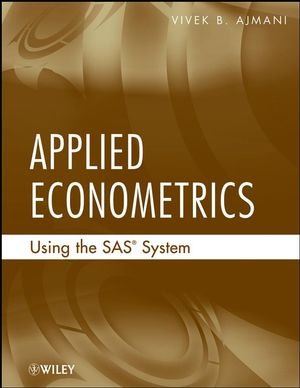|
Textbook
Applied Econometrics Using the SAS SystemISBN: 978-0-470-12949-4
Paperback
328 pages
June 2009, ©2009
 This is a Print-on-Demand title. It will be printed specifically to fill your order. Please allow an additional 10-15 days delivery time. The book is not returnable.
|
||||||
Acknowledgments.
1 Introduction to Regression Analysis.
1.1 Introduction.
1.2 Matrix Form of the Multiple Regression Model.
1.3 Basic Theory of Least Squares.
1.4 Analysis of Variance.
1.5 The Frisch–Waugh Theorem.
1.6 Goodness of Fit.
1.7 Hypothesis Testing and Confidence Intervals.
1.8 Some Further Notes.
2 Regression Analysis Using Proc IML and Proc Reg.
2.1 Introduction.
2.2 Regression Analysis Using Proc IML.
2.3 Analyzing the Data Using Proc Reg.
2.4 Extending the Investment Equation Model to the Complete Data Set.
2.5 Plotting the Data.
2.6 Correlation Between Variables.
2.7 Predictions of the Dependent Variable.
2.8 Residual Analysis.
2.9 Multicollinearity.
3 Hypothesis Testing.
3.1 Introduction.
3.2 Using SAS to Conduct the General Linear Hypothesis.
3.3 The Restricted Least Squares Estimator.
3.4 Alternative Methods of Testing the General Linear Hypothesis.
3.5 Testing for Structural Breaks in Data.
3.6 The CUSUM Test.
3.7 Models with Dummy Variables.
4 Instrumental Variables.
4.1 Introduction.
4.2 Omitted Variable Bias.
4.3 Measurement Errors.
4.4 Instrumental Variable Estimation.
4.5 Specification Tests.
5 Nonspherical Disturbances and Heteroscedasticity.
5.1 Introduction.
5.2 Nonspherical Disturbances.
5.3 Detecting Heteroscedasticity.
5.4 Formal Hypothesis Tests to Detect Heteroscedasticity.
5.5 Estimation of b Revisited.
5.6 Weighted Least Squares and FGLS Estimation.
5.7 Autoregressive Conditional Heteroscedasticity.
6 Autocorrelation.
6.1 Introduction.
6.2 Problems Associated with OLS Estimation Under Autocorrelation.
6.3 Estimation Under the Assumption of Serial Correlation.
6.4 Detecting Autocorrelation.
6.5 Using SAS to Fit the AR Models.
7 Panel Data Analysis.
7.1 What is Panel Data?
7.2 Panel Data Models.
7.3 The Pooled Regression Model.
7.4 The Fixed Effects Model
7.5 Random Effects Models..
8 Systems of Regression Equations.
8.1 Introduction.
8.2 Estimation Using Generalized Least Squares.
8.3 Special Cases of the Seemingly Unrelated Regression Model.
8.4 Feasible Generalized Least Squares.
9 Simultaneous Equations.
9.1 Introduction.
9.2 Problems with OLS Estimation.
9.3 Structural and Reduced Form Equations.
9.4 The Problem of Identification.
9.5 Estimation of Simultaneous Equation Models.
9.6 Hausman’s Specification Test.
10 Discrete Choice Models.
10.1 Introduction.
10.2 Binary Response Models.
10.3 Poisson Regression.
11 Duration Analysis.
11.1 Introduction.
11.2 Failure Times and Censoring.
11.3 The Survival and Hazard Functions.
11.4 Commonly Used Distribution Functions in Duration Analysis.
11.5 Regression Analysis with Duration Data.
12 Special Topics.
12.1 Iterative FGLS Estimation Under Heteroscedasticity.
12.2 Maximum Likelihood Estimation Under Heteroscedasticity.
12.3 Harvey’s Multiplicative Heteroscedasticity.
12.4 Groupwise Heteroscedasticity.
12.5 Hausman–Taylor Estimator for the Random Effects Model.
12.6 Robust Estimation of Covariance Matrices in Panel Data.
12.7 Dynamic Panel Data Models.
12.8 Heterogeneity and Autocorrelation in Panel Data Models.
12.9 Autocorrelation in Panel Data.
Appendix A Basic Matrix Algebra for Econometrics.
B.1 Assigning Scalars.
Appendix C Simulating the Large Sample Properties of the OLS Estimators.
Appendix D Introduction to Bootstrap Estimation.
Appendix E Complete Programs and Proc IML Routines.
References.
Index



